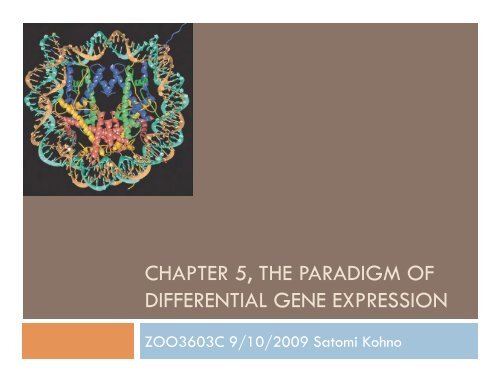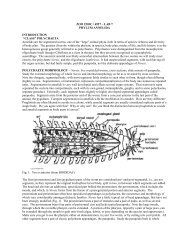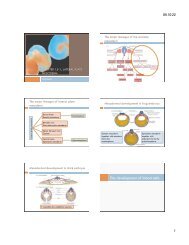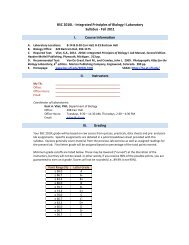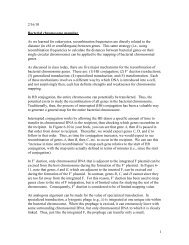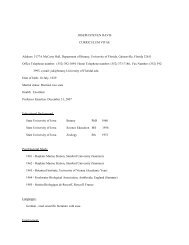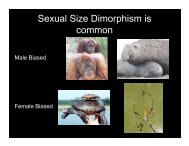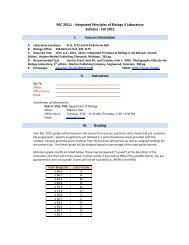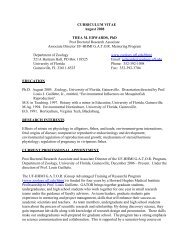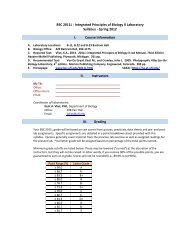indivd
indivd
indivd
You also want an ePaper? Increase the reach of your titles
YUMPU automatically turns print PDFs into web optimized ePapers that Google loves.
An integrated account of gene expression I12346751. Receptor activation2. Transcription factor activation3. Nuclear localization4. Chromatin decompaction5. Coupled initiation and 5’capping6. Coupled transcription andmRNA processing7. Splicing
An integrated account of gene expression II8 Cleavage and 3’polyadenylation9 mRNA packaging10 mRNA export10981211 Translation12 Protein folding and release13 Protein modification1113
An integrated account of gene expression I12346751. Receptor activation2. Transcription factor activation3. Nuclear localization4. Chromatin decompaction5. Coupled initiation and 5’capping6. Coupled transcription andmRNA processing7. Splicing
1. Receptor activation1 Juxtacrine Direct contact betweenthe inducing andresponding cells. Paracrine Diffusion of inducersfrom cell to another. Endocrine Travel through theblood to exert theireffects. Autocrine Secrete paracrineinducers also respondto them.
An integrated account of gene expression I12346751. Receptor activation2. Transcription factor activation3. Nuclear localization4. Chromatin decompaction5. Coupled initiation and 5’capping6. Coupled transcription andmRNA processing7. Splicing
Chromatin decompactionMechanical and chemical modificationson the chromatin regulate geneexpressions.4• Dosage compensation• Methylation• Insulator
Nucleosome and chromatin structureChromatin:a complex of DNAand protein, histoneHeterochromatin: highly coiled chromatin; inactive for transcription.Euchromatin: normal chromatin; active for transcription.
Chromatin decompactionMechanical and chemical modificationson the chromatin regulate geneexpressions.4• Dosage compensation• Methylation• Insulator
Inactivation of a single X chromosome inmammalian XX cellsXX femaleBarr BodiesX chromosome contained a lacZ genemaking -galactosidase. If this Xactivated, the cells would become blue.XXX femaleHeterocromatic Xchromosome becomesa Barr Body.X chromosome inactivation: imprintingInitiated by XIST?
X chromosome inactivation in mammalsX chromosome contain an orange allele for pigmentation gene,and the other X chromosome bear a black allele for thatpigmentation gene.
X chromosome inactivation in mammals (Part 1)
X chromosome inactivation in mammalsBoth ActiveNo imprintingPaternal inactivePaternalinactiveRandomly ActiveBoth Active
Chromatin decompactionMechanical and chemical modificationson the chromatin regulate geneexpressions.4• Dosage compensation• Methylation• Insulator
DNA methylationMethylation stabilizes nucleosomes and prevents transcriptionfactor from binding.
Methylation of globin genes in human embryonicblood cellsMethylation pattern changes during development.DNA methylations are on enhancer or promoter region:genomic imprinting
Chromatin modification induced by DNAmethylation Histone H3 Inactive = Methylation ↔ Active = Acetylation Methylation of histone H3 increases the nucleosome’sstability.1. MeCP2 binds to methylated regions of DNA andhistone deacetylase.2. EZH2 binds to DNA methyltransferase which wouldmethylate DNA and histone.3. Histone H1 binds to methylated regions of DNA.4. Heterochromatin.
Chromatin decompactionMechanical and chemical modificationson the chromatin regulate geneexpressions.4• Dosage compensation• Methylation• Insulator
The BEAF32 Insulators in Drosophilla1. prevent the enhance formactivating an adjacentpromoter.2. prevent the condensedchromatin of neighboringloci from repressing theactively transcribed gene.Yellow: overlap of green & redGreen: anti-BEAF32 insulator antibodyRed: propidium iodide, an intercalating agent for dsDNA.
Insulators on folate/-globin genespreventing the enhance Keeping the enhance between insulatorspreventing the inactivationRecruiting acetyltransferases
An integrated account of gene expression I12346751. Receptor activation2. Transcription factor activation3. Nuclear localization4. Chromatin decompaction5. Coupled initiation and 5’capping6. Coupled transcription andmRNA processing7. Splicing
Basic anatomy of the genePromoter region: responsible for the binding of RNA polymeraseand the initiation of transcription.
Basic structures to regulate the transcription. Promoter: DNA site to initiate transcription;immediately upstream TATA box: part of promoter; about 30-bp upstreamfrom the first base Enhancer: controlling the efficiency of transcription;on the same chromosome at great distance Silencer: one type of enhancer; negative enhancer;can repress the transcription.Initiation of Transcription
Formation of the active eukaryotic transcriptioninitiation complex (Part 1)1. The TFIID complex binds tothe TATA box.2. TFIID is stabilized by TFIIA.3. TFIIB and TFIIH join thecomplex on the TATA box.
Formation of the active eukaryotic transcriptioninitiation complex (Part 2)4. TFIIE and TFIIF associatewith RNA polymerase II.5. RNA polymerase II ispositioned by TFIIB, and itscarboxy-terminal domainis bound by TFIID.6. The CTD is phosphorylatedby TFIIH and is releasedby TFIID; RNA polymeraseII can now transcribemRNA.
Transcription factor DNA-binding domain recognize DNA ofenhancer or promoterregion Trans-activating domain Interact with RNApolymerase Protein interactiondomain Modulate activity
Reporter gene assay To analyze theregulation of geneexpression. Enhancer Transcription factor Reporter -galactosidase Green fluorescentprotein Luciferase5’ 3’-gal? Upstreamenhancer of Pax6? Enhance is for optic cup.
Summary of the steps involved in the productionof -globin and hemoglobinNuclear RNA5’-cap: methylated guanosine on 5’-end of RNA; protectionfrom the exonucleases; need to bind to ribosome fortranscription.
An integrated account of gene expression I12346751. Receptor activation2. Transcription factor activation3. Nuclear localization4. Chromatin decompaction5. Coupled initiation and 5’capping6. Coupled transcription andmRNA processing7. Splicing
Coupled transcription and mRNA processing of-globin and hemoglobinNuclear RNAmRNA3’ polyA tail: the adenylate residues are put enzymatically;protection from the exonucleases Differential RNA Processing: RNA selection & differentialsplicing.
Roles of differential RNA processing duringdevelopment• mRNA should be in the cytoplasm to be translated --- RNA selection• Introns should be removed to be the mRNA --- RNA splicing
Regulation of ectoderm-specific gene expressionby RNA processingRegular HistologyRNA protection assayIn situ hybridizationwith exon probeOnly ectoderm expressed CyIIIamRNA, whereas endo/mesodermexpressed it as nRNA.
RNA protection assay
Alternative RNA splicing FgfR2 & Bcl-XDifferent localizationDifferent functionFgfR-2IIIb: Limb ectodermFgfR-2IIIc: Limb mesodermBcl-X L : inhibits program celldeath (apoptosis)Bcl-X S : induce apoptosis
An integrated account of gene expression II8 Cleavage and 3’polyadenylation9 mRNA packaging10 mRNA export10981211 Translation12 Protein folding and release13 Protein modification1113
5.39 An integrated account of gene expression(Part 3)1211 Translation12 Protein folding andrelease13 Protein modification1113
Control of gene expression at the level oftranslation After RNA reach to cytoplasm, there are some otherregulations. Differential mRNA longevity Selective inhibition of mRNA translation Control by cytoplasmic localization
Differential mRNA longevity The longer life of mRNA, the more protein can betranslated from it. The life time of mRNA is depending on the length ofpolyA tail and 3’-UTR (untranslated region) sequence.
Degradation of casein mRNA in the presenceand absence of prolactinCasein: major protein of milk.Prolactin: peptide hormone released from anterior pituitary; stimulatesmilk productions.
Control of gene expression at the level oftranslation After RNA reach to cytoplasm, there are some otherregulations. Differential mRNA longevity Selective inhibition of mRNA translation Control by cytoplasmic localization
Contribution of mRNA ends to translation1. Eukaryotic initiation factor-4E (eIF4E), eIF4A andeIF4G bind to 5’-cap.2. PolyA binding protein binds to polyA tail and eIF4G.3. Ribosome recognized mRNA.4. Active Translation
Translational regulation in oocytesMaskin links the 5’ and 3’ endsinto a circle by binding to CPEB(cytoplasmic polyadenylationelement-bindingprotein) andeIF4E.No TranslationSome Oocyte makes some mRNA without the methylated 5’-capto regulate the translation
The regulation of lin-14 mRNA translation bylin-4 RNAsThe lin-4 gene produces smallRNA that has complementarysequence of lin-14. The binding of lin-4 transcripts tothe lin-14 mRNA 3’-UTR causesdegradation of the lin-14 mRNA.microRNA (miRNA)
Current model for the formation and use ofmicroRNAs (Part 1)1. Initial RNA transcriptform hairpin loop.2. RNase (Drosha andDicer), which used inRNAi, process thestem-loop structuresto ss miRNA.
Current model for the formation and use ofmicroRNAs (Part 2)3. The miRNA is packedin RISC (RNA-inducedsilencing complex).4. RISC binds to the 3’UTR of mRNA, andinhibits translation orinduces mRNAcleavage.
The dsRNA-mediated gene silencing procedure
An integrated account of gene expression II8 Cleavage and 3’polyadenylation9 mRNA packaging10 mRNA export10981211 Translation12 Protein folding and release13 Protein modification1113Development /morphogenesis/physiology
Next Class on Sep-15 Chapter 7, Fertilization: Beginning a New Organism


